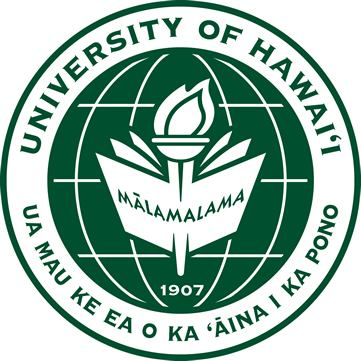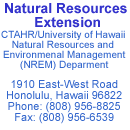| |
|
|
|
|
Hawaii is a member of the Southwest States and Pacific Islands Water Quality Coordination Team
|
| |
|
|
| |
 Livestock Manure Management in the American Pacific Islands, an article by Dr. Carl Evensen in the American Water Resources Association's (AWRA) publication IMPACT. (See pp 14-17). Dr. Evensen's article focuses on our regional experience with livestock waste management and the benefits and challenges it has had on water and soil quality. You can download a free copy here. Livestock Manure Management in the American Pacific Islands, an article by Dr. Carl Evensen in the American Water Resources Association's (AWRA) publication IMPACT. (See pp 14-17). Dr. Evensen's article focuses on our regional experience with livestock waste management and the benefits and challenges it has had on water and soil quality. You can download a free copy here.
|
|
 Hawaii Rainwater Catchment Service Directory. This directory is the first edition for rainwater catchment services and products on Hawaii island. The purpose of this directory is to be a single-point resources that owners of water catchment systems can use to find businesses that provide services for these systems. It includes valuable information -- from architects to water haulers. You can download a free copy here or pick up a print booklet (58 pages) at: Hawaii Rainwater Catchment Service Directory. This directory is the first edition for rainwater catchment services and products on Hawaii island. The purpose of this directory is to be a single-point resources that owners of water catchment systems can use to find businesses that provide services for these systems. It includes valuable information -- from architects to water haulers. You can download a free copy here or pick up a print booklet (58 pages) at:
Hawaii Rainwater Catchment Systems Association
c/o UH CTAHR NREM Cooperative Extension Service
Komohana Research and Extension Center
875 Komohana Street
Hilo, Hawai'i 96720
Phone: 808-981-5199
|
|

Conservation System Guides for Pacific Basin Beginning and Limited Resource Farmers and Ranchers. Through consultation with Pac Basin NRCS field and technical staff, five Conservation Systems Guides (CSGs) were chosen with widespread application for underserved farmer/rancher clients in the American Pacific. Based on Field Office Technical Guide (FOTG) information, Jody Smith and Luisa Castro developed five culturally appropriate Flash presentations demonstrating commonly used Pacific Basin CSGs. To reinforce the information delivered within the narrated presentations, they also developed 15 fact sheets to describe the CSG-related conservation practices. An additional introductory erosion control fact sheet is provided. Click on a title to open a PDF of the fact sheet.
Click on a title to access a narrated Flash presentation. [Note: Flash Player Security Warning - some of the links may give a warning. Simply click "OK" and the presentation should run as normal. This is due to a new security rules in Flash Player 8 (the following Articulate Support Pages have more information].
|
|
 Environmental Quality a chapter (pp. 41-50) by Carl I. Evensen and Katherine A.D. Chaston in Hawaii 2050: Building a Shared Future. This book, published by the Hawaii 2050 Sustainability Task Force, contains thoughtful papers and research background on
various issue areas which the Task Force identified as important for
Hawaii’s sustainable future. Scholars at the University of Hawaii provide
readers with information and ideas as we begin the serious deliberations for the future of our state. Link to the Hawaii 2050 web page http://hawaii2050.org/ to obtain the report as a PDF. Environmental Quality a chapter (pp. 41-50) by Carl I. Evensen and Katherine A.D. Chaston in Hawaii 2050: Building a Shared Future. This book, published by the Hawaii 2050 Sustainability Task Force, contains thoughtful papers and research background on
various issue areas which the Task Force identified as important for
Hawaii’s sustainable future. Scholars at the University of Hawaii provide
readers with information and ideas as we begin the serious deliberations for the future of our state. Link to the Hawaii 2050 web page http://hawaii2050.org/ to obtain the report as a PDF.
|
|
 Water
Issues in Hawaii: A Survey of Public Attitudes Water
Issues in Hawaii: A Survey of Public Attitudes
This 12-page
publication discusses a survey designed to measure attitudes
and perceptions among the general public about water issues,
to benchmark water conservation behaviors, and to evaluate
the potential effectiveness of communicating about water issues
using different media. Link to the CTAHR web page
to obtain the report as a PDF http://www.ctahr.hawaii.edu/oc/freepubs/pdf/WI-2.pdf
|
|
 Water
Warriors Community Guidebook Water
Warriors Community Guidebook
A
limited supply of Water Warriors, a community guidebook outlining
the 2004 EPA Award-winning Kuleana Eco-project is now available.
The 115-page guidebook describes the 2003-4 survey project
involving 12 schools in the Manoa Valley subwatershed area,
as well as the Water Warrior Challenge and the Kuleana Eco-Fair
conducted in the fall of 2004.
The book
covers: 7 steps to conducting a watershed outreach campaign
and lessons learned along the way; what worked and what should
have done differently; a calendar of events; a media directory;
a watershed conservation contacts and information resources
list; and an addendum of the grant request, the survey, letters,
forms, and other materials created for the project. Free copies
will be made available to schools, libraries, and non-profit
and educational groups, upon request. Call Helen Nakano at
(808) 988-5671 or Email her: nakano@aloha.net
|
|
 Water
Quality on the Island of Oahu Hawaii Water
Quality on the Island of Oahu Hawaii
Anthony,
S.S., Hunt, C.D., Brasher, A., Miller, L.D., and Tomlinson, M.S.
(2004). Water Quality on the Island of Oahu Hawaii, 1999–2001.
U.S. Geological Survey Circular 1239. Link to the USGS web page
to obtain the report as a PDF http://water.usgs.gov/pubs/circ/2004/1239/#pdf
This study is the most comprehensive water quality assessment ever
done in Hawaii. Although conducted for the island of Oahu, it is
representative of conditions throughout the state and is helpful
in understanding potential for water quality impairments in other
tropical island ecosystems. Dr. Carl Evensen provided a technical
review for this paper (see pages 8 and 40 of the pdf file).
|
|
 Guidelines
on Rainwater Catchments Systems for Hawaii Guidelines
on Rainwater Catchments Systems for Hawaii
This publication addresses water quality issues from the raindrop
to the faucet. It includes chapters on water collection, water
storage, water treatment, water testing, and firefighting concerns,
and it gives an overview of the typical kinds of catchment equipment
used in Hawaii. These guidelines are intended as a practical
reference on the major concerns and best management practices
for proper maintenance of rainwater catchments and storage systems.
Link to the College of Tropical Agriculture and Human Resources'
web page to obtain the report as a PDF http://www2.ctahr.hawaii.edu/oc/freepubs/pdf/RM-12.pdf
|
|
Hawaii’s Pollution
Prevention Information
The HAPPI (Hawaii's Pollution Prevention Information) Home Series is a set of 16 informational worksheets
developed to address water-pollution issues in and around your home. The documents are in pdf format. Use Adobe Acrobat Reader to view them.
The HAPPI (Hawaii's Pollution Prevention Information) Farm Series is a set of 10 information
and assessment materials developed to address different water pollution issues
faced by agricultural operations. The documents are in pdf format. Use Adobe Acrobat Reader to view them.
|
|
|
 Water
Resources Research Center (WRRC) Water
Resources Research Center (WRRC)
Researchers have produced ~400 technical reports,
technical memoranda, and other project reports documenting the
research performed at the WRRC since its establishment. These reports
represent one of the most extensive collections of research results
on water issues in Hawaii and the Pacific. Link to the WRRC
publication web page to
view their materials.
|
|
 Hawaii
Regional Water Quality Program Hawaii
Regional Water Quality Program
Clicking on any of the links below will take you
to Hawaii's Regional
Water Quality Program web site where you will find publications
corresponding to each of the bulleted themes.
Note: some of the publications require Adobe Acrobat Reader 4.0
or higher for viewing and printing. If you do not have the latest
version of the Adobe Acrobat Reader, get it by clicking here.
|
|
|
|
| Cooperative Extension Service programs, conducted in
cooperation with the U. S. Department of Agriculture, are
provided to the people of Hawaii without regard to race, sex,
age, religion, color, national origin, ancestry, disability,
marital status, arrest and court record, sexual orientation, or veteran status. The University is an equal opportunity /
affirmative action institution. |
|





 Hawaii
Regional Water Quality Program
Hawaii
Regional Water Quality Program
 Livestock Manure Management in the American Pacific Islands, an article by Dr. Carl Evensen in the American Water Resources Association's (AWRA) publication IMPACT. (See pp 14-17). Dr. Evensen's article focuses on our regional experience with livestock waste management and the benefits and challenges it has had on water and soil quality. You can download a free copy
Livestock Manure Management in the American Pacific Islands, an article by Dr. Carl Evensen in the American Water Resources Association's (AWRA) publication IMPACT. (See pp 14-17). Dr. Evensen's article focuses on our regional experience with livestock waste management and the benefits and challenges it has had on water and soil quality. You can download a free copy  Hawaii Rainwater Catchment Service Directory. This directory is the first edition for rainwater catchment services and products on Hawaii island. The purpose of this directory is to be a single-point resources that owners of water catchment systems can use to find businesses that provide services for these systems. It includes valuable information -- from architects to water haulers. You can download a free copy
Hawaii Rainwater Catchment Service Directory. This directory is the first edition for rainwater catchment services and products on Hawaii island. The purpose of this directory is to be a single-point resources that owners of water catchment systems can use to find businesses that provide services for these systems. It includes valuable information -- from architects to water haulers. You can download a free copy  Environmental Quality a chapter (pp. 41-50) by Carl I. Evensen and Katherine A.D. Chaston in Hawaii 2050: Building a Shared Future. This book, published by the Hawaii 2050 Sustainability Task Force, contains thoughtful papers and research background on
various issue areas which the Task Force identified as important for
Hawaii’s sustainable future. Scholars at the University of Hawaii provide
readers with information and ideas as we begin the serious deliberations for the future of our state. Link to the Hawaii 2050 web page
Environmental Quality a chapter (pp. 41-50) by Carl I. Evensen and Katherine A.D. Chaston in Hawaii 2050: Building a Shared Future. This book, published by the Hawaii 2050 Sustainability Task Force, contains thoughtful papers and research background on
various issue areas which the Task Force identified as important for
Hawaii’s sustainable future. Scholars at the University of Hawaii provide
readers with information and ideas as we begin the serious deliberations for the future of our state. Link to the Hawaii 2050 web page  Water
Issues in Hawaii: A Survey of Public Attitudes
Water
Issues in Hawaii: A Survey of Public Attitudes Water
Warriors Community Guidebook
Water
Warriors Community Guidebook Water
Quality on the Island of Oahu Hawaii
Water
Quality on the Island of Oahu Hawaii Guidelines
on Rainwater Catchments Systems for Hawaii
Guidelines
on Rainwater Catchments Systems for Hawaii  Water
Resources Research Center (WRRC)
Water
Resources Research Center (WRRC)
